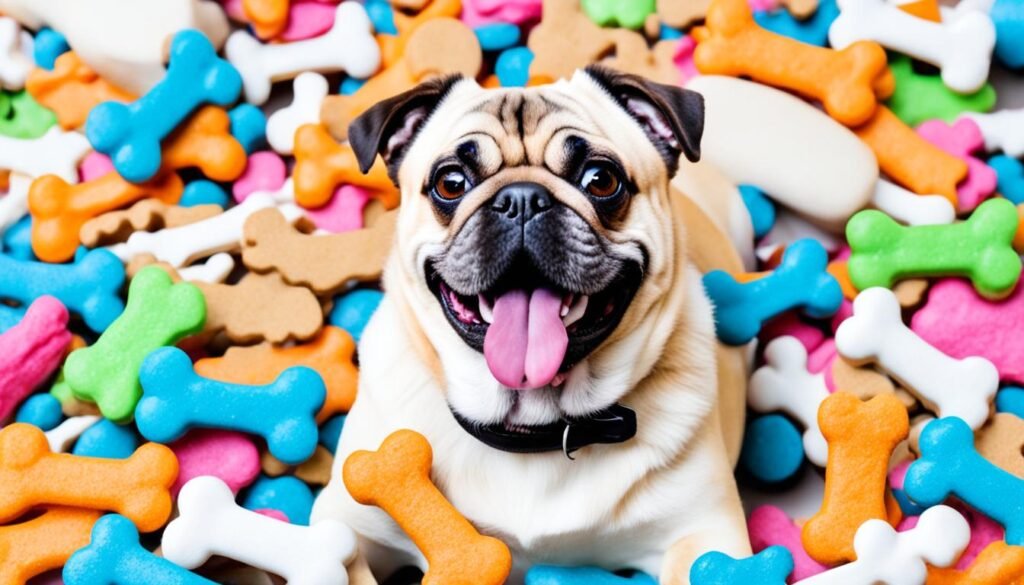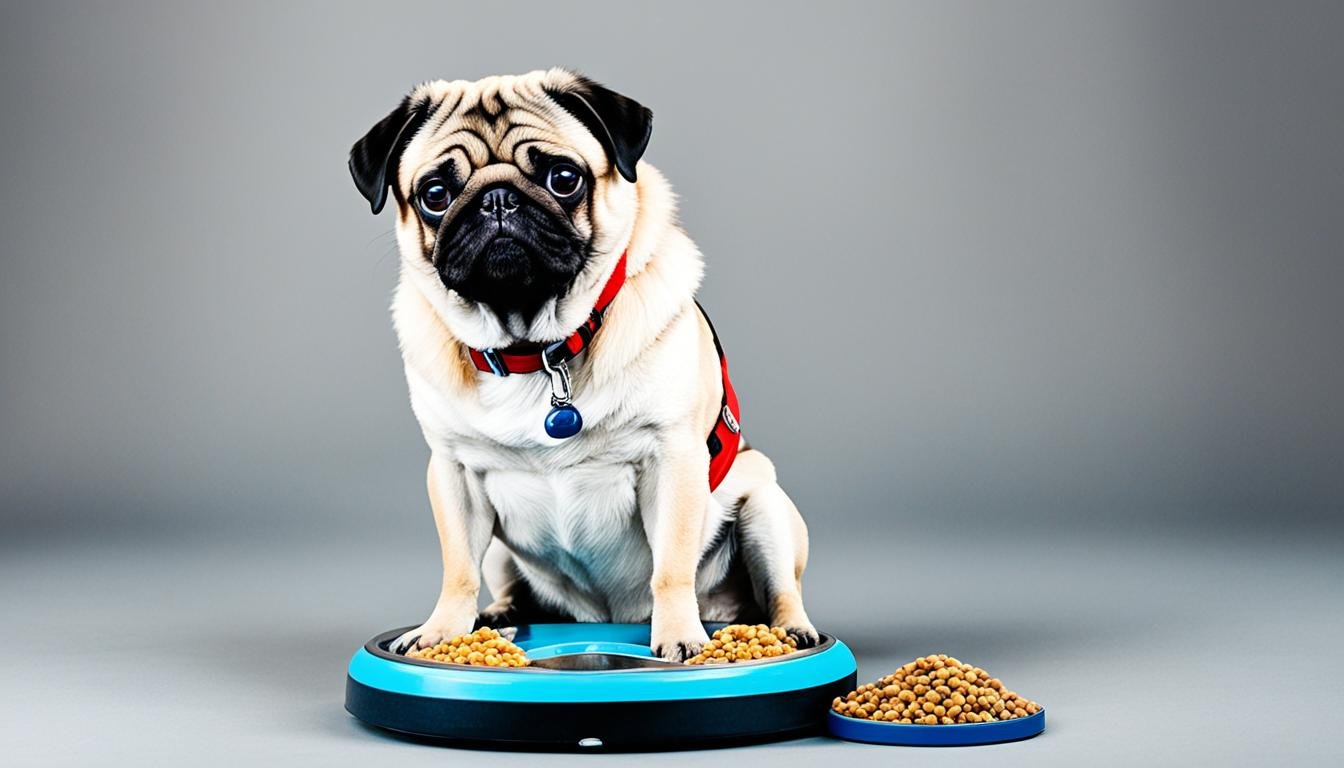The Biggest Mistakes People Make When Feeding Pugs
When it comes to feeding pugs, there are several common mistakes that people make. By avoiding these mistakes, you can ensure that your pug stays healthy and well-nourished. Let’s take a look at the biggest mistakes pet owners make when feeding their pugs, according to veterinarian experts.
Overfeeding and Not Following Feeding Instructions
One of the biggest mistakes people make when feeding pugs is overfeeding and not following the recommended feeding instructions on commercial pet food packaging. This can have serious consequences for your pug’s health and well-being.
When it comes to pug weight management, it’s crucial to understand that obesity in pugs is a common issue. Pugs have a tendency to gain weight easily, so it’s important to be mindful of their calorie intake. Overfeeding can lead to excessive weight gain, which can put strain on their joints and lead to a range of health problems.
Many pet owners rely on the suggested serving sizes listed on the food bag, assuming they provide accurate guidance. However, these serving sizes may not be appropriate for every dog. Every pug is unique and may have different calorie needs depending on their age, activity level, and overall health.
To ensure your pug maintains a healthy weight, it’s crucial to work with your veterinarian to determine the appropriate portion sizes for your dog. Your vet can take into account your pug’s specific needs and help you create a feeding plan that supports their weight management goals.
In addition to portion control, it’s also important to choose the right dog food for pugs. Look for high-quality dog food that is specifically formulated for small breeds or pugs. These formulas often contain balanced nutrition and appropriate calorie levels to support their overall health and weight management.
Giving Inappropriate Treats and Feeding from the Table
When it comes to feeding your beloved pug, avoiding certain mistakes is crucial for their overall health and well-being. One common mistake that many pug owners make is giving inappropriate treats and feeding them from the table.
Pugs have a tendency to beg for food, and it can be tempting to share your meals or snacks with them. However, this can lead to a host of problems. Feeding pugs treats from your hand can reinforce negative behaviors, such as begging and even biting. They begin to associate your hands with food, making it difficult to enjoy a meal in peace.
Not only does feeding pugs from the table create behavioral issues, but it can also have negative effects on their health. Pugs are prone to allergies and digestive issues, and consuming human food can exacerbate these problems. Unhealthy pug treats can contain ingredients that are harmful to their sensitive digestive system, leading to discomfort and potential complications.
It’s important to avoid giving your pug unhealthy treats and feeding them from the table. Instead, opt for dog-friendly treats that are specifically formulated for their nutritional needs. These treats are made with wholesome ingredients that support their overall health without causing digestive upset or allergies.
Remember, keeping your pug’s diet in check is essential for their well-being. Be mindful of the treats you choose and resist the temptation to feed them from the table. Your pug will thank you for it with a healthy and happy life.

Free-Feeding and Meal Frequency
When it comes to responsible pug feeding, free-feeding is a practice that should be avoided. Free-feeding refers to leaving food out for your pug to graze on throughout the day. While it may seem convenient, this approach can lead to weight issues and overeating for most pugs.
Pugs, like many other dogs, have a tendency to consume more calories than they need if given constant access to food. This can quickly lead to obesity, which comes with a range of health problems including joint issues, heart disease, and decreased lifespan.
To ensure your pug maintains a healthy weight, it’s essential to establish a feeding schedule and provide measured portions. By offering meals at set times, you have better control over their calorie intake. Regular meal times also help create a structured routine that pugs thrive on.
The frequency of meals may vary depending on your pug’s size and activity level, but as a general guideline, feeding them twice a day with evenly spaced meals is recommended. If you have any concerns about your pug’s weight or nutritional needs, it’s always best to consult with your veterinarian to develop a customized feeding plan.
By following responsible pug feeding practices and avoiding free-feeding, you can help your pug maintain a healthy weight and overall well-being.

Spoiling and Responding to Squealing
One common mistake that pug owners make is spoiling their adorable pups and responding to every squeal they make. While it may be tempting to give in to their demands, this can actually lead to behavioral issues in your pug.
Pugs are highly intelligent and quickly learn that squealing gets them what they want. If you constantly respond to their squeals by giving them treats or attention, they will continue to use this behavior to manipulate you.
It’s important to establish boundaries and not respond to every squeal. By ignoring the squealing, you can teach your pug that it does not lead to any rewards or attention. This is an essential part of pug training and will help you maintain control and a healthy dynamic with your furry friend.
Remember, consistency is key when it comes to pug behavior. Stick to the rules you set and don’t let your pug manipulate you with their adorable squeals. By being firm and consistent with your training, you’ll ensure that your pug grows into a well-behaved and happy companion.
Allowing Undesirable Behavior and Inconsistency in Rules
When it comes to pug training and responsible pet ownership, one common mistake many owners make is allowing undesirable behavior and being inconsistent with their rules. It may be tempting to let your pug sleep in your bed or turn a blind eye to naughty behavior, but this can have long-term consequences.
Pugs, like any other dog breed, thrive on structure and routine. They look to their owners for guidance and boundaries. If you don’t establish rules from the beginning and stick to them, it can lead to confusion and a lack of discipline.

It’s important to remember that pugs will test the boundaries you set. They are notorious for being stubborn and will push the limits to see what they can get away with. By allowing undesirable behavior or being inconsistent with your rules, you inadvertently send mixed signals and make it harder for your pug to understand what is expected of them.
To avoid this, it’s crucial to establish clear rules and boundaries for your pug from day one. Be consistent in enforcing these rules and follow through with any consequences or rewards. By doing so, you not only prevent undesirable behavior but also foster a strong bond based on trust and respect.
Consistency is key in pug training and responsible pet ownership. Make sure everyone in your household is on the same page and follows the established rules. This helps to create a structured environment that your pug can thrive in.
Remember, training your pug requires patience, time, and consistency. It’s a gradual process, and setbacks may happen along the way. Stay committed, and seek professional guidance if needed. With the right approach and consistent reinforcement of the rules, your pug will learn and grow into a well-behaved and happy companion.
Importance of a Balanced and Nutritious Diet
Finally, when it comes to feeding your pug, ensuring they have a balanced and nutritious diet is of utmost importance. A well-rounded diet not only promotes their overall health and well-being but also addresses specific health concerns that pugs may face.
One crucial factor in their diet is avoiding cereals. Pugs are more prone to allergies and skin issues, which can be exacerbated by the consumption of cereals. Choosing high-quality pet food that is free from cereals can help prevent such problems and keep your pug’s coat and skin healthy.
Consulting with your veterinarian is important for getting recommendations on specific brands of pet food that meet your pug’s nutritional needs. They can guide you regarding the right balance of proteins, fats, carbohydrates, vitamins, and minerals that a pug requires in their daily diet. Additionally, if you prefer to feed a raw or homemade diet, seek guidance from a veterinary nutritionist to ensure it meets all nutritional requirements.
Note: This text contains the SEO relevant keywords “Pug Diet” and “Pug Nutrition” evenly throughout the text.

